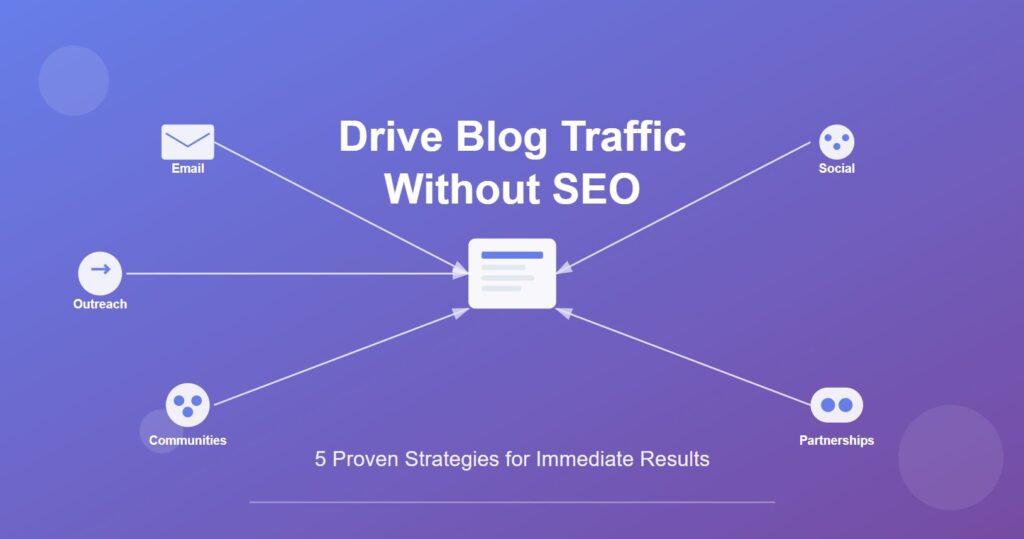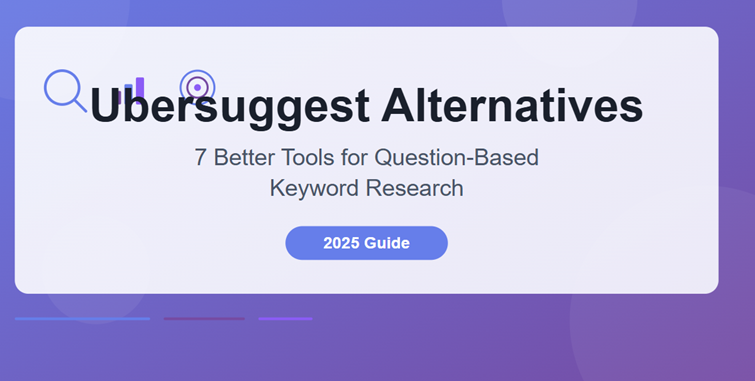Search engine optimization is often touted as the holy grail of blog traffic generation. While SEO certainly has its merits, it’s not the only path to building a thriving blog audience. In fact, many successful bloggers generate substantial traffic through alternative strategies that can deliver faster results and create more engaged readerships.
If you’re frustrated with the slow pace of SEO results, operating in a highly competitive niche, or simply want to diversify your traffic sources, this comprehensive guide will show you proven methods to drive significant blog traffic without depending on search engine rankings.
The Problem with SEO-Only Strategies
Before diving into alternatives, it’s important to understand why relying solely on SEO can be limiting. Search engine optimization typically requires months of consistent effort before showing meaningful results. Google’s algorithm changes can devastate traffic overnight, and ranking for competitive keywords often requires substantial resources and time.
Additionally, SEO traffic, while valuable, doesn’t always translate to the most engaged audience. Visitors finding your content through search queries may be in information-gathering mode rather than ready to engage deeply with your brand or convert into loyal readers.
Five Powerful Non-SEO Traffic Strategies
1. Build an Email-First Approach
The most sustainable approach to blog traffic generation starts with building an owned audience through email marketing. Rather than hoping potential readers will discover your content through search engines, this strategy involves actively building a subscriber base and driving them to your blog content.
Implementation Strategy:
Create compelling lead magnets that solve specific problems for your target audience. These might include downloadable guides, templates, checklists, or exclusive content that provides immediate value. Promote these lead magnets across social media platforms, in online communities, and through partnerships with other creators.
Once you’ve built your email list, develop a consistent newsletter schedule that highlights your latest blog content. Each newsletter should provide value independently while naturally directing subscribers to your blog for more detailed information. This approach ensures you have a direct line to your audience that no algorithm can disrupt.
Why This Works:
Email subscribers have already expressed interest in your content and are significantly more likely to visit your blog than random search traffic. You maintain complete control over this relationship, and email consistently delivers higher engagement rates than social media or search traffic.
2. Master Social Media Amplification
Transform every blog post into a comprehensive social media campaign that reaches your audience across multiple platforms. This isn’t about simply sharing links – it’s about creating platform-specific content that provides value while driving traffic back to your blog.
Platform-Specific Approaches:
Twitter Strategy: Convert your blog posts into engaging thread formats that summarize key points while encouraging readers to visit your blog for the complete analysis. Share thought-provoking quotes from your articles and engage in conversations that naturally reference your content.
LinkedIn Excellence: Create professional carousel posts that break down complex topics from your blog into digestible slides. LinkedIn’s algorithm favors native content, so provide substantial value in your posts while positioning your blog as the source for deeper insights.
Visual Platforms: For Instagram and TikTok, create visually appealing content that teases your blog topics. Use formats like “5 Things You Need to Know About [Topic]” where you share the headlines but direct viewers to your blog for detailed explanations.
Content Repurposing Framework:
Every blog post should generate multiple pieces of social content. A single comprehensive article can become seven to ten social media posts, each tailored to its platform’s unique audience and format preferences. This multiplies your content’s reach and provides multiple touchpoints for potential readers to discover your blog.
3. Become a Valuable Community Member
One of the most effective ways to drive targeted traffic involves becoming a recognized, helpful presence in communities where your ideal readers already congregate. This strategy requires genuine engagement and value-first thinking rather than promotional posting.
Reddit Mastery:
Identify subreddits relevant to your niche and become an active, helpful member. Answer questions thoroughly, share insights from your experience, and occasionally reference your blog content when it directly addresses someone’s question. The key is maintaining a 90/10 ratio – 90% pure value, 10% subtle promotion. You can use tools like Whazzuup to quickly surface high-intent questions and engage with your potential readers.
Facebook Group Engagement:
Join Facebook groups where your target audience discusses topics related to your blog. Participate regularly in discussions, share valuable insights, and build relationships with group administrators and active members. When your expertise becomes recognized, group members will naturally seek out your content.
Professional Communities:
Many industries have active Discord servers, Slack communities, or specialized forums. Joining these communities and consistently contributing valuable insights can establish you as a thought leader in your space, naturally driving traffic to your blog.
Community Engagement Best Practices:
Success in community marketing requires patience and authentic engagement. Focus on being genuinely helpful rather than promotional. Share insights, answer questions, and build relationships. When you do share your content, ensure it directly addresses the community’s needs and interests.
4. Leverage Strategic Partnerships
Collaboration can dramatically expand your reach by tapping into other creators’ audiences. This approach involves building mutually beneficial relationships that drive traffic to all participants’ blogs.
Podcast Guest Appearances:
Pitching yourself as a podcast guest can expose your expertise to entirely new audiences. Research podcasts in your niche, craft personalized pitches that highlight the unique value you can provide, and prepare talking points that naturally reference your blog content without being overly promotional.
Content Collaborations:
Partner with other bloggers or content creators for joint projects. This might involve co-authoring articles, creating shared resources, or developing complementary content that cross-references each other’s blogs. These partnerships can introduce your content to established audiences who trust your collaborator’s recommendations.
Newsletter Cross-Promotion:
If you’re building an email list, consider newsletter swaps with other creators in complementary niches. This allows you to introduce your content to highly engaged audiences while providing fresh perspectives to your own subscribers.
Influencer Outreach:
Build relationships with micro-influencers in your niche who might find your content valuable for their audiences. Rather than asking for direct promotion, focus on creating content that naturally aligns with their interests and expertise.
5. Implement Direct Outreach Strategies
Sometimes the most effective approach involves proactively sharing your content with people who might find it valuable. This requires research and personalized communication but can yield high-quality traffic and potential long-term relationships.
Media and Journalist Outreach:
If your blog covers topics that journalists might reference, build relationships with reporters in your field. Offer yourself as an expert source and share relevant insights from your blog content when appropriate. This can lead to authoritative backlinks and exposure to new audiences.
Industry Leader Engagement:
Identify thought leaders in your space and engage meaningfully with their content. Share thoughtful responses, contribute valuable insights, and gradually build relationships that might lead to content sharing or collaboration opportunities.
Creating Shareable Content
Regardless of your traffic generation strategy, success depends on creating content that people want to share and engage with. Focus on developing articles that provide immediate value while encouraging deeper exploration of your blog.
High-Performance Content Types:
Data-Driven Analysis: Original research, surveys, or data analysis that provides unique insights into your industry tends to generate significant sharing and linking from other content creators.
Comprehensive Guides: In-depth tutorials that solve specific problems for your audience establish your blog as a valuable resource and encourage bookmarking and sharing.
Contrarian Perspectives: Well-reasoned opinions that challenge conventional wisdom in your field can spark discussions and drive traffic from social media and communities.
Behind-the-Scenes Content: Authentic insights into your process, failures, and lessons learned create connection with readers and encourage sharing.
Resource Compilations: Curated lists of tools, tips, or resources that save your audience time and effort tend to perform well across all traffic channels.
Measuring Success Beyond Search Rankings
When implementing non-SEO traffic strategies, traditional metrics like keyword rankings become less relevant. Instead, focus on measurements that indicate genuine audience engagement and growth.
Key Metrics to Track:
Monitor direct traffic to your blog, which indicates people are actively seeking out your content. Track social media referral traffic to understand which platforms and content types drive the most visitors. Measure email click-through rates to gauge how effectively your newsletters drive blog traffic.
Pay attention to engagement metrics like time on page, pages per session, and comment activity. These indicators often show higher quality than search traffic, as visitors from email and social media tend to be more invested in your content.
Traffic Quality Indicators:
Non-SEO traffic often converts better than search traffic because visitors arrive with higher intent and familiarity with your brand. Track conversion rates for email signups, product sales, or whatever actions matter most for your blog’s goals.
Implementation Timeline and Expectations
Success with non-SEO traffic strategies requires consistent effort and realistic timeline expectations. Unlike SEO, which can take six to twelve months to show results, these approaches can generate traffic within weeks, but they require ongoing engagement to maintain momentum.
Month 1-2: Foundation Building
Establish your email marketing system and create several high-quality lead magnets. Identify and join relevant communities where your audience congregates. Begin consistent social media posting and engagement.
Month 3-4: Relationship Development
Focus on building genuine relationships within communities and with other content creators. Start pitching podcast appearances and exploring collaboration opportunities. Refine your content repurposing process based on early results.
Month 5-6: Optimization and Scaling
Analyze which strategies generate the highest quality traffic and double down on those approaches. Begin exploring paid amplification for your highest-performing content. Develop systems to maintain consistency while scaling your efforts.
Overcoming Common Challenges
Time Management: These strategies require more active engagement than SEO, which can feel overwhelming. Combat this by batching similar activities and using scheduling tools to maintain consistency without constant manual effort.
Platform Dependency: Relying heavily on social media or other platforms creates risk if algorithms change or accounts face restrictions. Mitigate this by diversifying across multiple channels and always driving traffic to owned assets like your email list.
Consistency Pressure: Unlike SEO, which can generate passive traffic, these approaches require ongoing effort. Build sustainable systems and realistic expectations to avoid burnout while maintaining the consistency necessary for success.
Conclusion
While SEO remains a valuable long-term strategy, bloggers who diversify their traffic sources often build more resilient and engaged audiences. The strategies outlined in this guide can generate immediate results while creating genuine relationships with readers who become loyal advocates for your content.
The key to success lies in choosing approaches that align with your strengths and consistently providing value before seeking anything in return. Whether you focus on email marketing, social media amplification, community engagement, or strategic partnerships, remember that sustainable traffic growth comes from building authentic relationships with your audience.
Start with one or two strategies that feel most natural to your style and gradually expand your approach as you build momentum. With dedication and genuine value creation, you can build substantial blog traffic without depending solely on search engine rankings.



